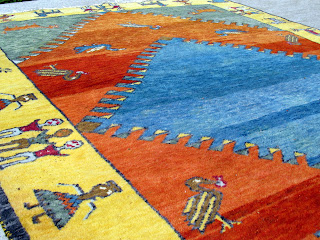I am in love!
The beautiful rich colours remind me of natural dyes. The fact that they kept running low of one colour or dye lot, and had to 'blend' new colours into the mat really adds a something special to the rug.
The label says it's hand knotted, and I can easily believe it.
But where is it from? Can anyone recognize the style? We have a great difference of opinion in the house of what country (and continent) it might be from. Any experts out there?
 |
| notice how the label is missing the country and city of origin. |
Have a look at these animals and people, see if it inspires any clues.
I also need to repair the edges. Anyone know a good tutorial?







4 comments:
That's a really amazing rug. I know nothing about rugs, but what a cool find.
According to the people on ravelry (who know everything and are way smarter than google when it comes to yarn based things - http://www.ravelry.com/discuss/remrants/2141665 )
The rug is Gabbeh style, from Persia.
A few more details.
The warp is cotton, 4, 2ply strands plied together... about the weight of kitchen twine.
The weft is wool or other animal fibre. There is between 2 to 5% guard hairs in the yarn. The guard hairs did not take up the dye as well as the regular wool.
The weft is woven with several singles (1ply) strands held together. There is about 4 strands of yarn per shed.
I wasn't able to make out what style of knot was used. But if I had, here is a good link I could use to learn more about where this rug is from: http://www.nejad.com/consumer/anatomy_of_a_rug.htm
Because it's so tightly knotted, it's difficult to tell if the weft is hand spun or not. Arguments in favour of hand spun are the slight variation in thickness and twist, and the frequent joins in the weft yarn (even where the same colour is used). Although it could just be a really basics and uneven mill spun yarn.
As for natural dyes... it is possible to get those colours using natural dye methods, but you can also get them using synthetic dyes. I am undecided if this is natural or synthetic dye - if there was some way to use my microscope to find out which... please let me know.
I'm glad someone on Ravelry could help you identify the style and origin of the rug. The answer you've gotten confirms the thought I was having about it possibly being from Iran.
I've seen relatively little about the rug industry when I was in Iran, but nowhere have I seen any handspun yarn or any mention of spinning yarn for rug making - which is not to say that it doesn't exist, simply I wasn't exposed to it through the very little I've seen. I remember seeing a shop where they were dyeing yarn, but I wouldn't be able to tell if they were using natural or synthetic dyes - it was during my first trip there, and my Persian was extremely limited (at best!) at the time...
As for the style of knot used - I once came across a very good reference book about Persian rugs, and I remember there were great illustrations and explanations of the different knot styles. I'll see if I can find the title again. It was in French, but even if there wasn't an English version, the pictures would help a lot and I could translate the relevant explanations.
I'm sorry I can't be more helpful - but I'm grateful that your post brought back those lovely memories. Thank you!
Post a Comment